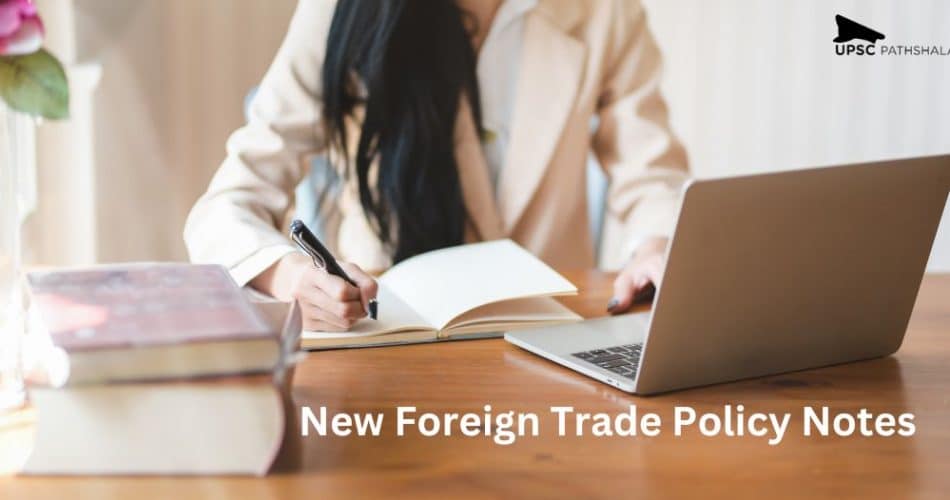The New Foreign Trade Policy 2023 has recently been announced by the Indian government, and it is expected to have a significant impact on the country’s trade relations with other nations. This policy is aimed at promoting exports, attracting foreign investment, and creating employment opportunities in India. Aspirants preparing for the UPSC exam should be well-versed with the latest updates on this policy as it is an important topic for the exam.
In this blog, we will discuss the key highlights of the New Foreign Trade Policy 2023 and the potential implications it may have on India’s economy. We will also examine the various measures being taken by the government to achieve its goals and the challenges that lie ahead. So, buckle up and get ready to grab the latest information on this important trade policy that will shape India’s future in the global market.
New Foreign Trade Policy 2023 UPSC
The previous policy, which had been in effect since 2015, has been replaced by a new policy that will take effect from the 2023-24 financial year. The objective of the new policy is to raise India’s goods and services exports to $2 trillion by 2030, nearly tripling the estimated figure of $760 billion in 2022-23.
Under the previous policy, exports grew by 75%, from $435 billion in 2015-16 to $760 billion in 2022-23. Despite this growth, India’s global share in merchandise exports and services exports remains low, prompting the government to aim for a growth rate of 7% to 10%.
Also Read: How to ace your UPSC Prelims Preparation? Let’s Check Out the Best UPSC Preparation Methods
Latest Foreign Trade Policy Provisions
The latest foreign trade policy will not have a sunset date and will be adjusted based on industry feedback and emerging global trade scenarios. Although the policy will remain open-ended, the schemes authorized under it will have specific time frames. There are no major new schemes, with the exception of a one-time amnesty under the existing Advance Authorisation and Export Promotion Capital Goods (EPCG) schemes that allow imports of capital goods subject to specified export obligations.
The new policy has opened up a new area for potential exports known as “merchanting trade,” which involves an Indian intermediary shipping good from one foreign country to another foreign country without touching Indian ports. This will also facilitate exports of restricted goods. Additionally, four towns in Uttar Pradesh have been identified as centres of export excellence for their performance in apparel, handicrafts, handmade carpets and handlooms, respectively.
To help the clothing and apparel sector respond more quickly to market demands and fashion trends, the policy intends to introduce a special advance authorisation scheme. Furthermore, it plans to lower qualification thresholds for star ratings that recognize exporters based on their export performance.
Notes on Challenges of Foreign Trade Policy for UPSC 2023
These notes on Foreign Trade Policy for UPSC 2023 highlight some of the major challenges facing Indian exporters. One of the biggest hurdles is the low access to trade finance and export credit, which is especially problematic for Micro, Small, and Medium Enterprises (MSMEs) that makeup almost half of India’s total exports. Compared to other countries, Indian exporters receive far less financial support, with export credit agencies providing only $7.6 billion in funds in India compared to China’s $39.1 billion.
Bureaucracy is another issue that hinders the export process in India. The high documentation requirement means that Indian exporters must prepare a large set of documents for each stage of the shipping process, leading to more time consumption. Additionally, certification authorities at Indian ports are not available round the clock or on all days of the week, making it necessary to plan.
Inadequate infrastructure is also a significant challenge, as India’s infrastructure is considered to be the weakest link. According to data firm Statista, India’s score for infrastructure quality in 2019 was 68.1 out of 100, with top-ranked Singapore scoring 95.4 and bottom-ranked Bolivia scoring 57.1, only slightly lower than India.
Also Read: Constitutional Morality: Check Out the UPSC Notes and Prepare for the UPSC CSE!
More Information on the New Foreign Trade Policy 2023 UPSC
In an effort to boost exports from India, several schemes have been introduced under the Foreign Trade Policy. One such scheme is the Remission of Duties or Taxes on Export Product (RoDTEP) which is a fully automated route for Input Tax Credit (ITC) under the GST regime. This helps in avoiding double taxation and the cascading effect of taxes by providing ITC for taxes paid on the purchase of raw materials, consumables, goods, or services used in manufacturing.
Another scheme is the Rebate of State and Central Taxes and Levies which is offered for embedded state and central duties and taxes that are not refunded through GST, and was earlier only available for garments. The Merchandise Exports from India Scheme (MEIS) was introduced in the Foreign Trade Policy (FTP) 2015-20, under which the government provides duty benefits based on the product and country.
MEIS duty credit scrip can be transferred or used for payment of several duties including the basic customs duty. Additionally, a Common Digital Platform for Certificate of Origin has been launched to facilitate trade and increase Free Trade Agreement (FTA) utilization by exporters.
Also Read: How Useful is the UPSC Test Series? The Best One is Here for the UPSC Aspirants!
Conclusion
In conclusion, staying updated with the latest developments in Foreign Trade Policy is essential for anyone preparing for the UPSC exams. If you’re planning to appear for the UPSC exams, UPSC Pathshala can be an excellent resource to help you prepare for the Foreign Trade Policy-related questions in the exams. With experienced mentors, comprehensive study material, and a personalized approach to learning, UPSC Pathshala can help you achieve your dream of cracking the UPSC exams and pursuing a career in civil services.







